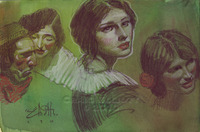"Sculpting" forms
Craig Elliott
One way to simplify the process and not become overwhelmed by all the parts of what you are trying to draw is to do something I call "Sculpting" the form. So named because it is the same proceedure that you would use if you were sculpting something out of clay. Starting with the most simple masses you can see in what you are drawing you gradually, step by step, add more masses from large all the way down to small.
I have seen the students of Howard Pyle, the father of American illustration, use this technique very often and believe he must have taught something similar in his classes. N.C. Wyeth, Harvey Dunn and their students use this all the time. In addition to this being a drawing proceedure, it is also a way to indicate things further in the distance. The earlier in the process (largest forms and least detail) the drawing is the further away it will appear.
I have chosen a head from a Dean Cornwell painting to illustrate this idea:
1. The left sketch shows the first stage with very large masses, basically an egg of clay with a shelf on it for the eye area. this would be a good stage to stop at for distant figures and crowds. Only 2 values are used here.
2. The next sketch shows the addition of the nose, mouth and cheek subforms. There is also 1 slightly darker value introduced. The best use of this stage of figure is any mid-ground figure of medium importance.
3. Here the same values as the last drawing are used, but smaller forms like the eyes and lip subforms as well as details around the neck are added. Local values (such as the lips, pupils of the eyes and eyebrows) are added to some degree as well. This stage would work well for foreground figures that are not the main focus of the piece.
4. This is the final stage used for close up or focal point figures in paintings, with the final addition of a accent dark and light highlight value.
